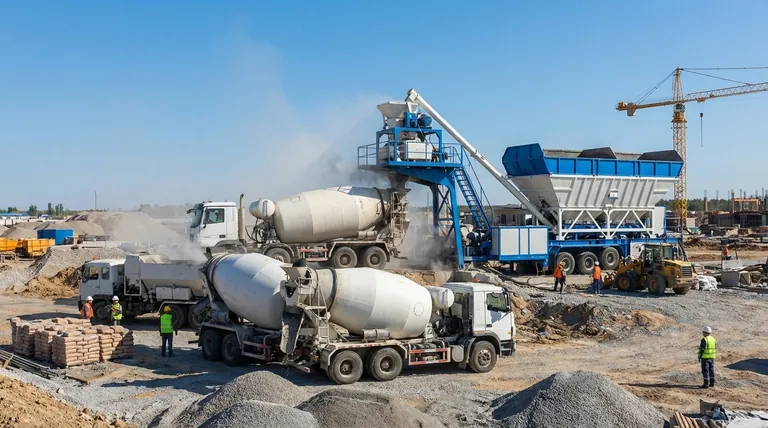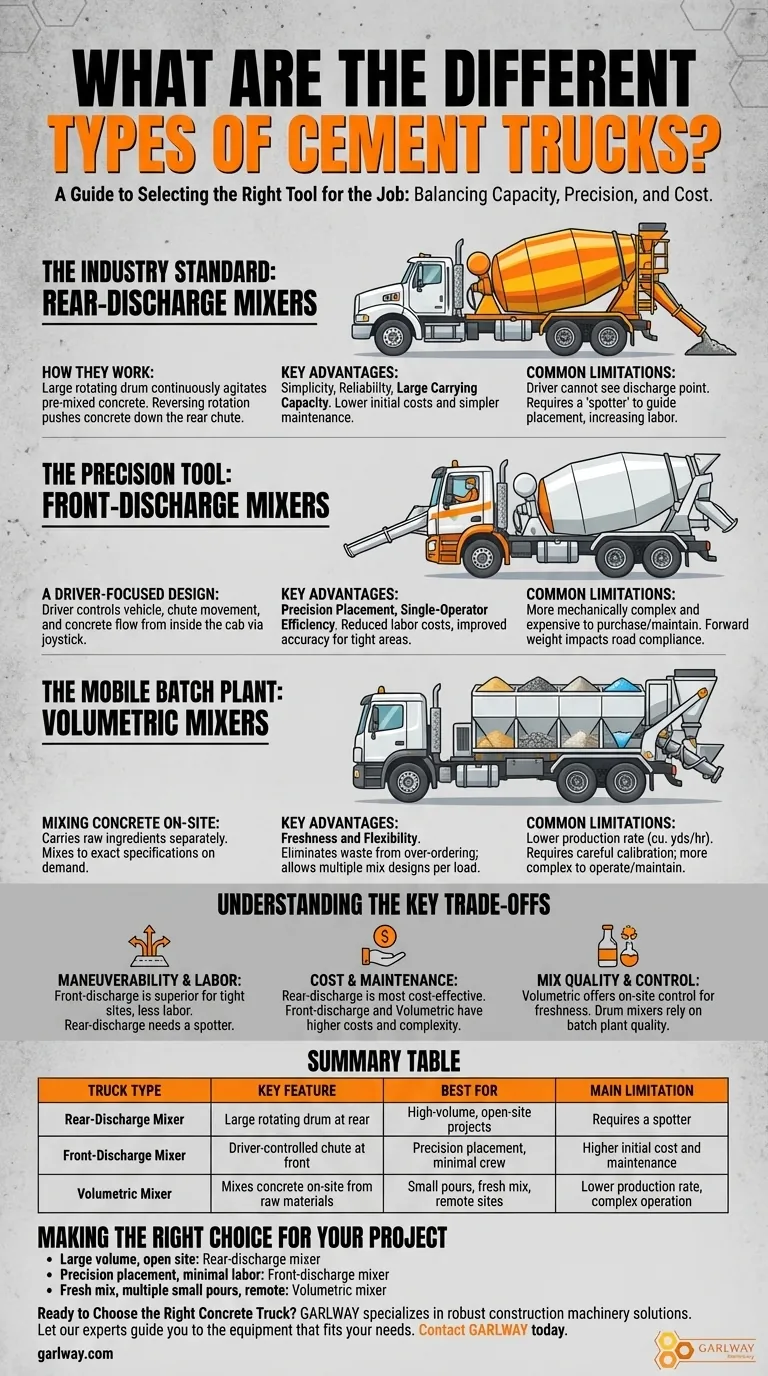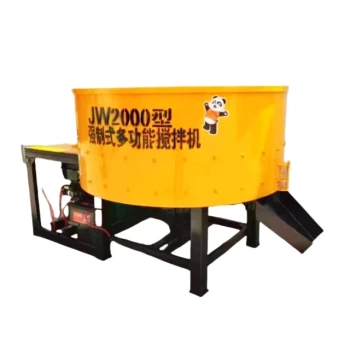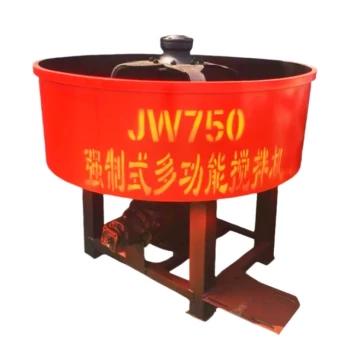While most people picture one specific vehicle, there are three primary types of trucks used to transport concrete and its components: the rear-discharge mixer, the front-discharge mixer, and the volumetric mixer. Each is designed as a specific solution for different job site challenges, balancing capacity, precision, and cost.
The choice of a concrete truck is not about which is universally "best," but about selecting the right tool for the job. The decision hinges on the specific needs of the pour, considering factors like site access, required precision, and the volume of concrete needed.

The Industry Standard: Rear-Discharge Mixers
This is the classic concrete truck that most people recognize. The large, rotating drum is mounted on the back of the chassis, discharging concrete down a chute at the rear.
How They Work
The iconic spinning drum contains spiral blades on the inside. As the drum rotates in one direction, it continuously agitates the pre-mixed concrete, keeping it from hardening during transport. Reversing the drum's rotation pushes the concrete out and down the discharge chute.
Key Advantages
Rear-discharge trucks are the workhorses of the industry due to their simplicity, reliability, and large carrying capacity. Their straightforward design generally leads to lower initial purchase costs and simpler maintenance compared to more complex models.
Common Limitations
The primary drawback is that the driver cannot see the point of discharge. This necessitates a second person (a "spotter") to guide the driver and help direct the chute, increasing labor requirements on the job site.
The Precision Tool: Front-Discharge Mixers
Also known as "bridge-mixers" or "badgers," these trucks place the cab and the discharge chute at the front, giving the driver direct control and visibility over the entire operation.
A Driver-Focused Design
The driver operates the vehicle and controls the chute's movement and the concrete flow from inside the cab using a joystick. This design allows for extremely precise placement of concrete without needing a second worker to guide the process.
Key Advantages
The main benefit is efficiency and precision. A single operator can drive to the location and place the concrete exactly where it's needed, significantly reducing labor costs and improving pour accuracy, especially in tight or complex areas.
Common Limitations
These trucks are more mechanically complex and expensive to purchase and maintain than their rear-discharge counterparts. The forward-mounted engine and cab also add to the vehicle's overall weight and can present different challenges for road weight compliance.
The Mobile Batch Plant: Volumetric Mixers
Unlike the other types that transport pre-mixed concrete, a volumetric mixer is essentially a mobile concrete plant. It carries all the raw ingredients—sand, stone, cement powder, and water—in separate compartments.
Mixing Concrete On-Site
The materials are mixed to exact specifications on the job site itself. This process allows the operator to start and stop the pour on demand, producing only the exact amount of concrete needed for the task at hand.
Key Advantages
The key advantage is freshness and flexibility. Since the concrete is mixed moments before it's poured, it's always at maximum strength potential. This design also eliminates waste from over-ordering and allows for multiple, smaller pours with different mix designs from a single truck load.
Common Limitations
Volumetric mixers typically have a lower production rate (cubic yards per hour) than a traditional drum mixer. They also require careful calibration to ensure mix consistency and are generally more complex to operate and maintain.
Understanding the Key Trade-offs
Choosing the right truck involves balancing competing priorities. Each design represents a different solution to the core challenges of transporting and placing a highly perishable product.
Maneuverability and Labor
Front-discharge mixers offer superior on-site maneuverability and reduce the need for extra labor, making them ideal for residential or congested sites. Rear-discharge trucks are simpler but almost always require a spotter to work effectively and safely.
Cost and Maintenance
The mechanical simplicity of rear-discharge trucks makes them the most cost-effective option for initial purchase and long-term maintenance. Front-discharge and volumetric mixers carry a higher price tag and involve more complex hydraulic and mechanical systems.
Mix Quality and Control
Volumetric mixers offer unparalleled control over mix design and freshness, preventing issues like a "hot load" (concrete that's starting to set). Drum mixers rely on the batch plant for initial quality, with the primary on-site control being the addition of water, which can compromise strength if not done correctly.
Making the Right Choice for Your Project
Your project's specific requirements will determine the best vehicle for the job.
- If your primary focus is large volume for an open, accessible site: The high capacity and simplicity of a rear-discharge mixer is the most efficient choice.
- If your primary focus is precision placement with minimal labor: A front-discharge mixer provides the control and efficiency needed for complex pours or smaller crews.
- If your primary focus is fresh mix, multiple small pours, or remote locations: A volumetric mixer offers unmatched flexibility and eliminates waste.
Ultimately, understanding the distinct purpose of each truck empowers you to ensure your concrete arrives and is placed with maximum efficiency and quality.
Summary Table:
| Truck Type | Key Feature | Best For | Main Limitation |
|---|---|---|---|
| Rear-Discharge Mixer | Large rotating drum at the rear | High-volume, open-site projects | Requires a spotter for safe operation |
| Front-Discharge Mixer | Driver-controlled chute at the front | Precision placement, minimal crew | Higher initial cost and maintenance |
| Volumetric Mixer | Mixes concrete on-site from raw materials | Small pours, fresh mix, remote sites | Lower production rate, complex operation |
Ready to Choose the Right Concrete Truck for Your Project?
Selecting the correct equipment is crucial for the efficiency, cost, and success of your concrete pour. GARLWAY specializes in providing robust construction machinery solutions, including concrete mixers and batching plants, tailored for construction companies and contractors worldwide.
Let us help you make the right choice. Our experts can guide you to the equipment that best fits your project's specific needs for volume, precision, and site conditions.
Contact GARLWAY today to discuss your requirements and ensure your next project is a concrete success!
Visual Guide

Related Products
- HZS75 Concrete Batching Plant Cement Mixer Price Concrete Mixer Bunnings Mixing Plant
- HZS180 Ready Mix Concrete Plant for Foundations with Sand and Cement
- Commercial Electric Concrete Mixer Machine HZS 50 Small Batch Plant for Sale
- HZS35 Small Cement Concrete Mixing Batch Plant
- Hydraulic Concrete Mixer Machine Cement Mixing Equipment for Mixture Concrete
People Also Ask
- What are the disadvantages of ready mixed concrete? Navigate Logistical & Cost Risks
- Do you put water or cement in a cement mixer first? Master the Professional Layering Method
- How to start a concrete plant business? A Step-by-Step Guide to Launching Your Venture
- How much weight can a cement mixer hold? A Guide to Choosing the Right Size for Your Project
- Can you mix self leveling concrete in a cement mixer? Avoid Costly Flooring Mistakes



















